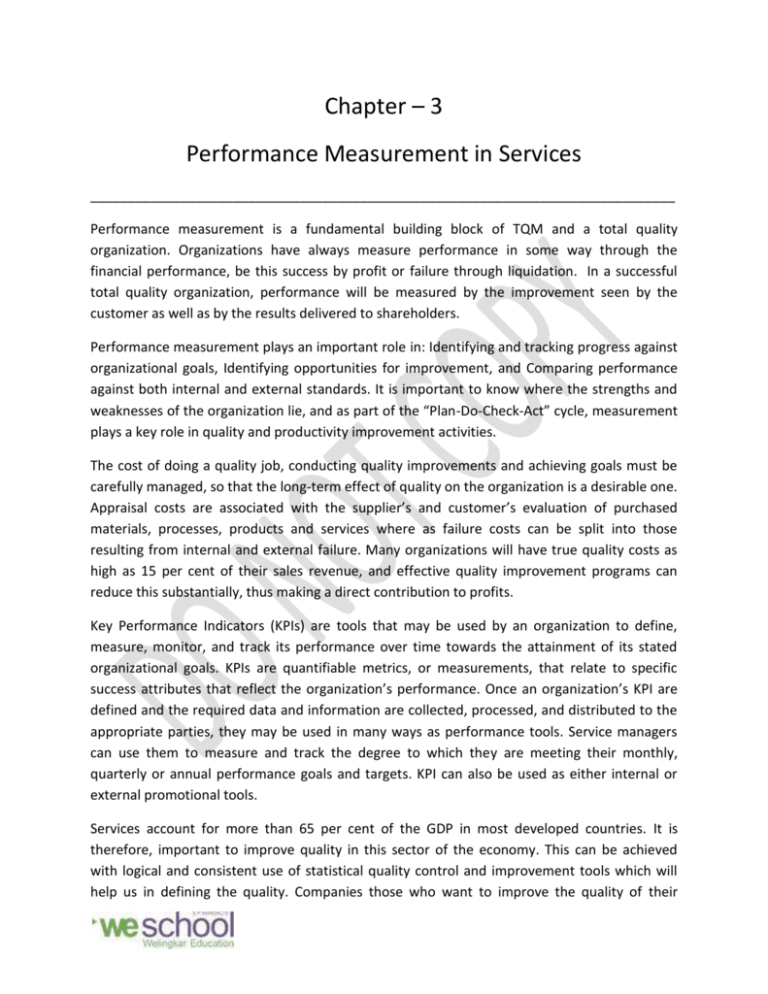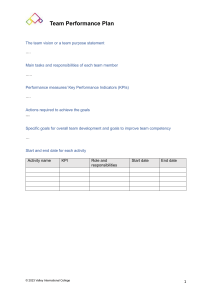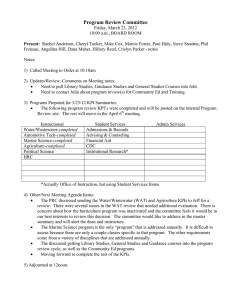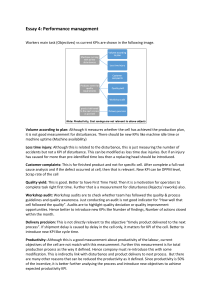chapter 3
advertisement

Chapter – 3 Performance Measurement in Services ______________________________________________________________________________ Performance measurement is a fundamental building block of TQM and a total quality organization. Organizations have always measure performance in some way through the financial performance, be this success by profit or failure through liquidation. In a successful total quality organization, performance will be measured by the improvement seen by the customer as well as by the results delivered to shareholders. Performance measurement plays an important role in: Identifying and tracking progress against organizational goals, Identifying opportunities for improvement, and Comparing performance against both internal and external standards. It is important to know where the strengths and weaknesses of the organization lie, and as part of the “Plan-Do-Check-Act” cycle, measurement plays a key role in quality and productivity improvement activities. The cost of doing a quality job, conducting quality improvements and achieving goals must be carefully managed, so that the long-term effect of quality on the organization is a desirable one. Appraisal costs are associated with the supplier’s and customer’s evaluation of purchased materials, processes, products and services where as failure costs can be split into those resulting from internal and external failure. Many organizations will have true quality costs as high as 15 per cent of their sales revenue, and effective quality improvement programs can reduce this substantially, thus making a direct contribution to profits. Key Performance Indicators (KPIs) are tools that may be used by an organization to define, measure, monitor, and track its performance over time towards the attainment of its stated organizational goals. KPIs are quantifiable metrics, or measurements, that relate to specific success attributes that reflect the organization’s performance. Once an organization’s KPI are defined and the required data and information are collected, processed, and distributed to the appropriate parties, they may be used in many ways as performance tools. Service managers can use them to measure and track the degree to which they are meeting their monthly, quarterly or annual performance goals and targets. KPI can also be used as either internal or external promotional tools. Services account for more than 65 per cent of the GDP in most developed countries. It is therefore, important to improve quality in this sector of the economy. This can be achieved with logical and consistent use of statistical quality control and improvement tools which will help us in defining the quality. Companies those who want to improve the quality of their products and processes need to concentrate their efforts on the proper exploration of data available in their records. Companies can gain a distinctive competitive advantage on the market by a consequent and consistent application of statistical tools. A distinguishing service feature, related to the interface with the customer, is most visible in the highly specialized segment of personal high-contact services. There, the customer needs to be physically present when receiving a service because the production and the delivery process are interdependent and thus inseparable. Today, many services providers are of the view that more the service features, better the quality. In a service industry, one has to be extremely careful that a feature is a cost to the company and inclusion of features will only add to the cost their by not giving a competition advantage to the service provider. Thus it is important to provide the customer with features which h is looking for. If statistical tools are applied to understand behavior of the customer pattern, there is a scope for increasing the service quality. The basic statistical toolbox includes a set of seven tools popularized by Kaoru Ishikawa, among them are check sheets, the Pareto chart, the cause-and-effect diagram, histograms, stratification, scatter plots and graphs. Experiments with influential factors have a great future potential in the service sector. They can be used to either improve an existing service delivery process or to design new services or quality planning process. According to Davidow and Uttal the essence of any customer service strategy is to segment the customers to be served with the goal of concentrating all efforts on a homogeneous set of customers that can be served at a profit. Information technology can be used to gain better understanding of the customers and help identify homogeneous customer subgroups that can be served with services tailor-made to their needs and expectations. The Six Sigma initiative is “a program aimed at the near elimination of defects from every product, process and transaction”. It is a disciplined quantitative approach for improvement of defined indicators in all types of business processes. XXXXXXXXXX











